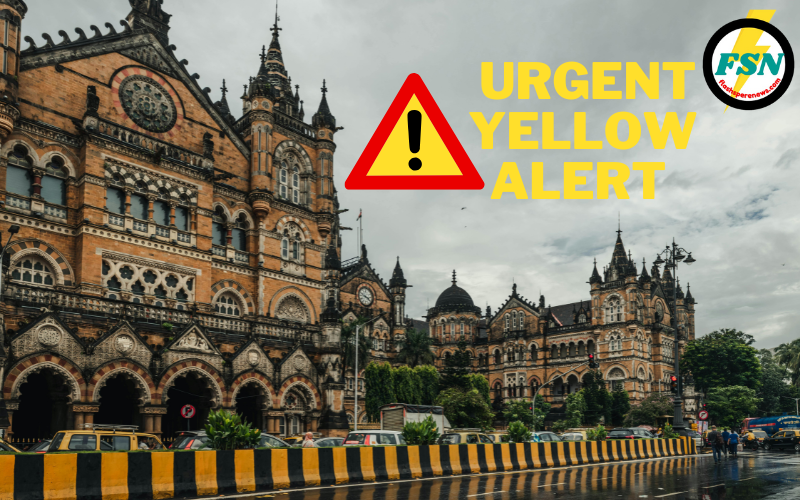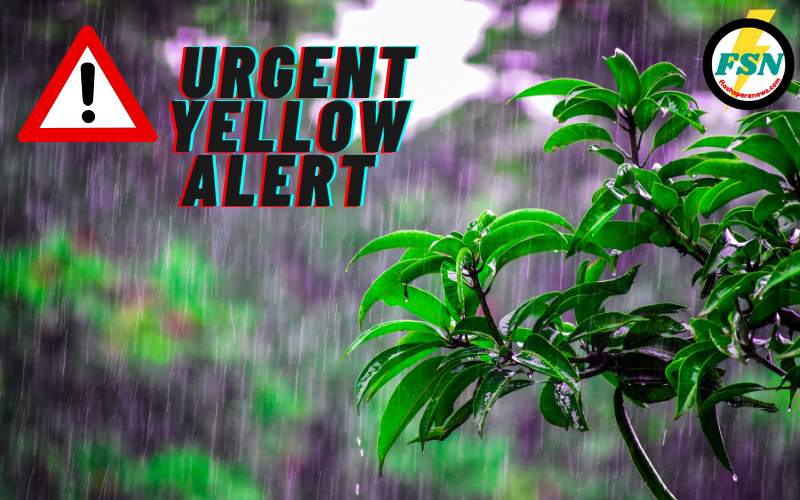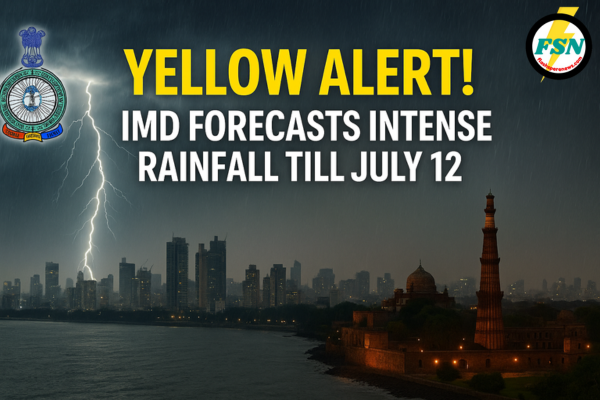Urgent Yellow Alert Issued Across India: IMD Forecasts Intense Rainfall in Mumbai, Delhi & Other Regions Till July 12

In a rapidly evolving monsoon scenario, the India Meteorological Department (IMD) has issued an Urgent Yellow Alert for several parts of the country, including the bustling metros of Mumbai and Delhi. The advisory, which covers a critical period up to July 12, signals a period of heavy to very heavy rainfall across various regions. The IMD’s Urgent Yellow Alert comes at a time when large parts of India are grappling with erratic monsoon behavior, waterlogging, traffic disruptions, and potential landslides in vulnerable zones.
The Urgent Yellow Alert serves as a preemptive measure to warn citizens, local authorities, and disaster response teams of the weather extremities expected to strike in the coming days. This weather development is more than just a routine monsoon shower; it poses significant challenges to daily life, especially in metro cities where even moderate rainfall can bring life to a halt.
According to the IMD, the rainfall is being driven by strong monsoonal westerly winds from the Arabian Sea and a low-pressure area forming over eastern India. The situation is being continuously monitored using Doppler Weather Radars and satellite imaging. Senior IMD officials mentioned that this pattern is likely to persist and may even intensify due to a possible interaction with western disturbances around July 10.
Mumbai, Delhi Brace for Intense Showers Amid Urgent Yellow Alert
Mumbai, the financial capital of India, is already witnessing substantial rainfall. The IMD has highlighted the likelihood of intense rainfall episodes coupled with thunderstorms and gusty winds in Mumbai and surrounding regions. The Urgent Yellow Alert warns that waterlogging, flight delays, and rail disruptions are highly likely. Mumbaikars have been advised to stay indoors during peak rainfall hours and avoid low-lying areas prone to flooding.
Local authorities have issued advisories to residents near the Mithi River and other smaller water bodies, which are rising rapidly due to continued downpours. The BMC has also deployed high-capacity water pumps in flood-prone zones and set up temporary shelters for residents who may need to evacuate.
Delhi is also under the grip of the Urgent Yellow Alert, with heavy showers predicted to continue until July 12. The capital has experienced fluctuating rainfall patterns with short but powerful bursts of precipitation. The IMD has alerted Delhiites to potential urban flooding, waterlogging, and traffic snarls, especially in areas with poor drainage systems. The administration has asked citizens to remain cautious and follow advisories strictly.
Rainfall in Delhi is expected to be accompanied by gusty winds reaching 30–40 km/h and localized hailstorms in some areas. The Public Works Department has conducted pre-monsoon inspections, yet many underpasses remain vulnerable to flooding.
Beyond these urban centers, several states including Uttarakhand, Himachal Pradesh, Odisha, Jharkhand, Chhattisgarh, West Bengal, Assam, Meghalaya, and Tripura are also under watch. The Urgent Yellow Alert in these states implies a heightened risk of landslides, flash floods, and river overflow in hilly and coastal zones. With multiple rivers flowing above danger levels and hilly terrains vulnerable to slides, residents of remote villages are being evacuated in advance to safer shelters.
In Uttarakhand’s Pithoragarh and Chamoli districts, local authorities have already shifted over 1,000 people from high-risk areas. Meanwhile, in Himachal’s Mandi district, heavy rainfall has caused landslides blocking the Chandigarh–Manali highway for several hours.
Urgent Yellow Alert Impacts Travel and Public Services
As the Urgent Yellow Alert remains in place, transportation systems across affected regions are on high alert. In Mumbai, the local railways—the city’s lifeline—have reported delays and slow-moving traffic due to waterlogged tracks. The Brihanmumbai Municipal Corporation (BMC) has deployed emergency squads to monitor and pump out excess water. In Delhi, the Public Works Department has also activated flood-control rooms and issued helpline numbers for residents facing waterlogging.
Airports in both cities have issued advisories warning of potential flight delays. Airlines have recommended that travelers check their flight statuses in advance and reach the airport with ample buffer time. Road traffic remains severely impacted, particularly in Mumbai’s Sion, Kurla, Andheri, and Dadar areas, as well as Delhi’s Ring Road and ITO intersection.
The Urgent Yellow Alert is not only disrupting travel but also putting a strain on civic infrastructure. Overflowing drains, blocked culverts, and debris-clogged waterways have forced authorities to conduct round-the-clock monitoring and maintenance.
In Kolkata, the city’s civic authorities have issued alerts to all borough offices. Special attention is being paid to areas around the Hooghly River where tidal influx can combine with torrential rain to cause severe flooding. In Odisha, the state government has temporarily shut down schools and advised fishermen not to venture into the sea.
The Northeast Frontier Railway has cancelled over 20 trains and diverted others due to flooding and track washouts in Assam and Meghalaya. In Chhattisgarh, parts of Raipur and Bilaspur faced 10-hour power outages due to transformer damage caused by flooding.
Several states have cancelled or rescheduled intercity trains due to waterlogging on railway tracks. In parts of Odisha and Chhattisgarh, buses were halted in hilly areas prone to landslides. Farmers, too, have faced hardship, with livestock movement and transportation of agricultural produce to market centers severely impacted.
Health Risks and Safety Amid the Urgent Yellow Alert
The continuous rainfall under the Urgent Yellow Alert has heightened the risk of waterborne diseases. Municipal corporations have intensified efforts to chlorinate water tanks and distribute clean drinking water in flood-prone zones. Citizens are urged to avoid contact with contaminated water, consume boiled water, and seek immediate medical attention in case of symptoms such as diarrhea, vomiting, or skin infections.
Hospitals and emergency services are also on standby. The Delhi and Mumbai health departments have instructed all primary health centers to be equipped with additional medicine stock and emergency care facilities. Public awareness campaigns are being conducted through radio, TV, and social media to ensure people are well-informed about health precautions during this period of Urgent Yellow Alert.
Vector-borne diseases like dengue and malaria are a rising concern. Municipal bodies have launched fumigation drives in residential areas and near open drains. Citizens are being encouraged to wear full-sleeved clothes and use mosquito repellents. Flood-related electrocution and snakebite incidents have also been reported, particularly in Bihar and Assam.
Veterinary services are also on alert as cattle in submerged villages face dehydration and disease. Mobile veterinary units have been deployed in several districts, and animal shelters are being set up in raised areas.
Meanwhile, schools across Tripura and Jharkhand have been directed to switch to online mode temporarily. Children have been advised to avoid playing in rainwater due to the risk of infection and injury.
Economic Disruptions Loom as Urgent Yellow Alert Worsens
With the IMD maintaining the Urgent Yellow Alert till July 12, economic implications are becoming more visible. Markets in Mumbai and Delhi have witnessed reduced footfall, with many small businesses opting to remain closed on days of heavy downpour. Delivery services, including food and e-commerce, have reported delays and cancellations. Agricultural activities in the rain-soaked regions are also facing interruptions, especially in parts of Maharashtra, Chhattisgarh, and Odisha, where sowing has been delayed due to excessive moisture.
The monsoon is a lifeline for India’s agriculture-heavy economy, but erratic rainfall—as indicated by the Urgent Yellow Alert—has proven disruptive rather than beneficial. Farmers are being guided by agricultural extension services to delay sowing or use flood-resistant seeds in response to the IMD’s forecast.
Small-scale industries and local traders are reporting financial losses due to low productivity and lack of footfall. Construction work has slowed drastically, especially in flood-prone areas. Daily wage laborers are among the most affected groups as work opportunities dry up.

Insurance companies are anticipating a spike in claims related to property damage, vehicle issues, and crop failure. Logistics firms are rerouting packages and adjusting timelines, which could potentially impact festival-related shopping and supply chains, particularly with Raksha Bandhan and Independence Day approaching.
Tourism in Himachal Pradesh and Uttarakhand has taken a hit as hotels report cancellations amid travel advisories. The state governments have suspended trekking and camping activities and instructed operators to refund bookings.
Emergency Response Measures Intensify During Urgent Yellow Alert
The National Disaster Response Force (NDRF) has been deployed in several districts across Maharashtra, Uttarakhand, and Himachal Pradesh. These teams are equipped with inflatable boats, first aid, and communication devices to deal with emergencies. In Delhi, local disaster management authorities have started deploying boats in Yamuna-adjacent areas to prepare for potential rise in water levels.
The Urgent Yellow Alert has pushed district collectors and local administrations to activate emergency operation centers. Alerts are being shared through SMS, mobile apps, and social media. In Mumbai and Delhi, school authorities have been given discretionary powers to announce holidays depending on rainfall intensity.
Rescue efforts in northeastern states such as Assam and Meghalaya have also intensified, where riverbanks are reportedly close to breaching danger marks. Flood shelters have been opened, and food and medical supplies are being sent to remote areas.
Volunteers and NGOs are playing a crucial role in providing food packets, drinking water, and essential items to flood-affected populations. Coordination between central and state agencies has improved through real-time satellite imaging, enabling rapid identification of danger zones.
In Jharkhand, district-level emergency drills have been conducted to test readiness. States have also started identifying additional temporary shelters and stocking them with essentials like bedding, dry food, water bottles, and sanitation kits.
Climate Patterns and the Broader Context
Meteorologists note that the unusual monsoon behavior aligns with broader climate change trends. The Urgent Yellow Alert this year reflects a shift in rainfall intensity and distribution. Experts from the Indian Institute of Tropical Meteorology (IITM) and IMD suggest that warming oceans, particularly the Arabian Sea, are contributing to the formation of low-pressure systems that bring intense rainfall.
Data shows that India has witnessed a 15–20% increase in extreme rainfall events over the past decade. The Urgent Yellow Alert thus not only addresses immediate safety concerns but also points to the pressing need for long-term climate resilience.
Infrastructure upgrades such as smart drainage, real-time flood forecasting, and urban green zones are recommended by environmental planners. The IMD is also working to strengthen its early warning system, improve radar coverage, and engage in citizen-based rainfall reporting networks.
Climate scientists are advocating for adaptive city planning models that incorporate climate resilience, rooftop rainwater harvesting, and floodplain restoration. They emphasize the need for long-term policy planning that includes both climate mitigation and adaptation.
International climate bodies have also flagged India’s vulnerability to monsoon-related disasters, emphasizing the urgency of aligning national weather infrastructure with global early-warning systems.
Public Advised to Stay Informed and Prepared During Urgent Yellow Alert
Authorities have urged citizens to keep emergency kits ready, avoid non-essential travel, and closely monitor updates from the IMD. Helpline numbers are being circulated across television channels and social platforms to ensure timely communication during any crisis under the ongoing Urgent Yellow Alert.
The Indian Meteorological Department has been praised for its timely warnings and regular updates, which are helping cities to prepare in advance. However, with climate change causing increasingly unpredictable weather patterns, the Urgent Yellow Alert serves as a grim reminder of the urgent need for urban resilience planning and sustainable infrastructure development.
More rainfall is expected in the coming days. Citizens are advised to stay connected with IMD updates and follow civic guidelines as the Urgent Yellow Alert continues to dominate India’s monsoon narrative through July 12.
Conclusion
As India braces for days of relentless downpour, the IMD’s Urgent Yellow Alert stands as a critical lifeline. From metro cities to remote hill districts, the impact of the warning is both immediate and far-reaching. From travel disruptions to healthcare strains, economic setbacks to environmental implications, the alert reminds us of the delicate balance between nature’s force and human preparedness.
It is imperative that both citizens and authorities remain vigilant, cooperative, and proactive during this crucial period. The resilience shown now will determine not just how we weather this storm, but how prepared we are for those yet to come.
Let the Urgent Yellow Alert be a call to action—not just to survive this weather but to plan resiliently for a safer, more sustainable future.

